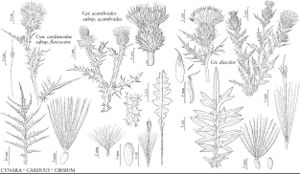Cynara cardunculus subsp. flavescens
Bot. J. Linn. Soc. 109: 120, fig. 15A–D, F–J. 1992.
Leaves armed with spines 1–3 cm. Middle phyllaries acute to short-acuminate at apex with point 10–21 mm and spine tip 2–5 (–6) mm, distal margins with prominent yellowish margins 0.5–1+ mm.
Phenology: Flowering spring–summer (Apr–Jul).
Habitat: Disturbed areas in grasslands, coastal scrub, chaparral, riparian habitats, fallow fields, roadsides
Elevation: 0–500 m
Distribution

Introduced; Calif., w Mediterranean region, Macaronesia
Discussion
Artichoke thistle is a noxious weed that tends to spread aggressively in overgrazed range lands and may invade undisturbed natural vegetation as well. Dense infestations form pure stands, sometimes several hec-tares in extent. The long, needlelike spines deter herbivores and the large rosettes suppress the growth of other plants. Vigorous root sprouts can develop from fragments of the deep taproots left in the soil by cultivation or mechanical clearing.
Selected References
None.
Lower Taxa
"fine" is not a number.
